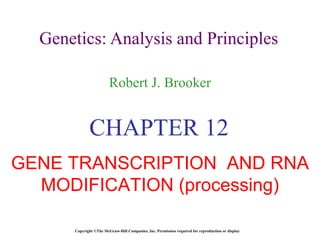Mais conteúdo relacionado Semelhante a Transcription and splicing. (20) Mais de Arshad Al-Ghafour (7) 1. Genetics: Analysis and Principles Robert J. Brooker Copyright ©The McGraw-Hill Companies, Inc. Permission required for reproduction or display CHAPTER 12 GENE TRANSCRIPTION AND RNA MODIFICATION (processing) 12. Copyright ©The McGraw-Hill Companies, Inc. Permission required for reproduction or display 12-16 Figure 12.4 The conventional numbering system of promoters Bases preceding this are numbered in a negative direction There is no base numbered 0 Bases to the right are numbered in a positive direction Most of the promoter region is labeled with negative numbers 13. Copyright ©The McGraw-Hill Companies, Inc. Permission required for reproduction or display 12-17 Figure 12.4 The conventional numbering system of promoters The promoter may span a large region, but specific short sequence elements are particularly critical for promoter recognition and activity level Sometimes termed the Pribnow box, after its discoverer Sequence elements that play a key role in transcription 14. Copyright ©The McGraw-Hill Companies, Inc. Permission required for reproduction or display 12-18 Figure 12.5 Examples of –35 and –10 sequences within a variety of bacterial promoters The most commonly occurring bases For many bacterial genes, there is a good correlation between the rate of RNA transcription and the degree of agreement with the consensus sequences 17. Copyright ©The McGraw-Hill Companies, Inc. Permission required for reproduction or display 12-21 Figure 12.6 Amino acids within the helices hydrogen bond with bases in the promoter sequence elements 19. 12-26 Similar to the synthesis of DNA via DNA polymerase Figure 12.8 On average, the rate of RNA synthesis is about 43 nucleotides per second! 21. 12-28 r ho ut ilization site Rho protein is a helicase -dependent termination Figure 12.10 31. 12-39 Figure 12.14 Copyright ©The McGraw-Hill Companies, Inc. Permission required for reproduction or display 32. 12-40 Figure 12.14 Copyright ©The McGraw-Hill Companies, Inc. Permission required for reproduction or display A closed complex Released after the open complex is formed RNA pol II can now proceed to the elongation stage 38. ‘ promoter’ Protein coding Difference in gene structure between - prokaryote - eukaryote core ‘ promoter’ An important difference between prokaryotes and eukaryotes is that eukaryotes’ genes are not split into intons and exons in eukaryotes is the DNA coding protein are. Therefore, exons eventually end up in the mRNA intron exons 39. Pre-mRNA Transcription start, elongation, termination and RNA processing in eukaryotes : coding protein : non-coding protein: ‘leader’ and ‘trailer’ CAP CAP (poly A tail) The longest gene in human genome is more than 1.500.000 base pares (bp) and the mRNA is ~ 7000 nt. That means: >1.493.000 bp intron = ~ 99,5 % !!!!! ‘ promoter’ intron exons GENE mRNA AAAAAAAAAAAAAAn 46. 12-70 Intron loops out and exons brought closer together Figure 12.22 Copyright ©The McGraw-Hill Companies, Inc. Permission required for reproduction or display 47. Copyright ©The McGraw-Hill Companies, Inc. Permission required for reproduction or display 12-71 Figure 12.22 Intron will be degraded and the snRNPs used again 55. Copyright ©The McGraw-Hill Companies, Inc. Permission required for reproduction or display 12-79 Figure 12.24 Consensus sequence in higher eukaryotes Appears to be important in the transport and stability of mRNA and the translation of the polypeptide Length varies between species From a few dozen adenines to several hundred
